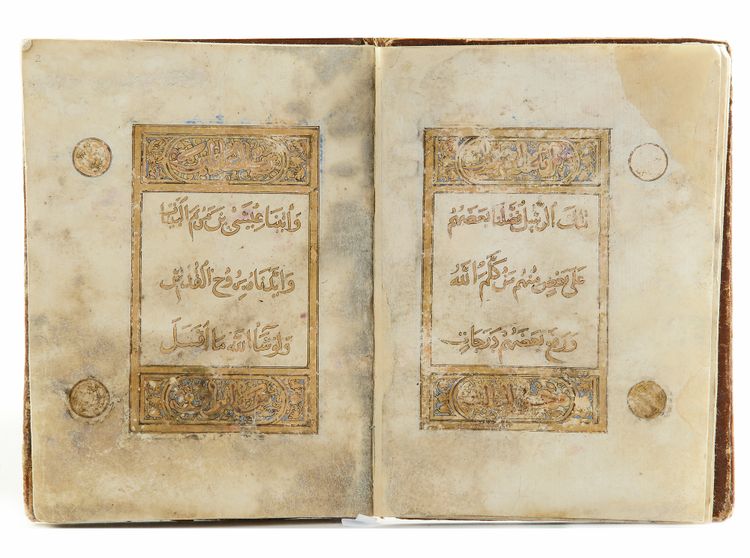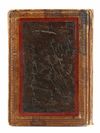THE THIRD SECTION OF THE QURAN BY IBN AL-BUSAYS, 13TH CENTURY
An Arabic manuscript on paper 41 leaves with 2-fly-leaves and with 5 lines to each page, written in elegant gold naskh script outlined in black with gold rosette markers. Large rosettes indicate each verse within the text, while a gold, pear-shaped device in the margin marks each khums and ‘ashr verse. Double page illuminated opening frontispiece in gold and polychrome. The manuscript is the third section of the Quran. The Quran, of course, contains 30 almost equal sections. 21.5 by 15.5 cm.
CATALOGUE NOTE
Al-Shaykh Najm al-Din Must Ibn Ali Ibn Muhammad al-Halabi al-Dimashqi (known as Ibn Busays), born in Aleppo in 651 AH/1253 AD and died in Damascus on 10th of Dhu al-Qidah of 716 AH/24 January 1317 AD. He was buried in al-Bab al-Saghir cemetery.
He appears to have learned the art of calligraphy from his father. He became the most famous and accomplished calligrapher in Damascus just as his contemporary, Yuqut al-Mustasimi ( died 1298), the most famous and accomplished calligrapher in Baghdad. The historian Ibn Kathir (1300 – 1373), when he was a teenager, met him and studied with him the art of calligraphy. He described Ibn Busays as a wonderful old man with very pleasant features. Ibn Busays continued to work as a calligrapher for about fifty years.
After learning all the major types of calligraphy of his day, he excelled in the thuluth type of calligraphy.
One of his greatest accomplishments is to write a khatma (complete Quran in thirty sections), near the end of his life, in a new style, which he called al-mujiz (the inimitable), where he used gold ink directly on paper instead of ordinary ink. It is clear that the present section belongs to that particular Quran because it seems to coiside with method used by him.
Among his other accomplishments is a commentary on Ibn al-Bawwab, titled Sharh Qasiat Ibn al-Bawwab fi Sinaat al-Kuttab (commentary on the Poem by Ibn a-Bawwab (died 1022) on the Art of Scribes). Ibn al-Bawwab’s poem is one of earliest treatises by a calligrapher on the necessary tools for good calligraphic writing, especially the mansub (the measured calligraphy). This commentary survived in summary form in a unique manuscript in the library ofArif Hikmat in Medina.
Ibn Busays was a humble man, who cultivated his own garden and repaired his house with his own hands. In essence, he believed in and was a follower of the Gilani order of Sufis. He even composed poems in that vein. Among the poems which survived are the following:
وحقّك لو خيرت فيما أريده
من الخير في الدنيا أو الحظ في الأخرى
لَما اخترت إلا حسن نظم يروقني
معانيه أبدي فيه أوصافك الكبرى
I swear if I were to be given the choice
Between good fortune of this life or the next
I would choose writing beautiful poetry
Expressing, Oh God, your magnificent bounties.
تشفع بِالنَّبِيِّ فَكل عبد يجار إِذا تشفع بِالنَّبِيِّ
وَلَا تجزع إِذا ضَاقَتْ أُمُور فكم لله من لطف خَفِي
Seek help from the Prophet Muhammad
For everyone will be protected if he seeks his help
Don’t be upset if things are tight
For God has endless hidden favors.
Sources:
Ibn Hajar al-Asqalani. Al-Durar al-Kamina fī Ayan al-Mi’a al-Thamina. Second Edition. Hyderabad, 1972.
Ibn Kathir. Al-Bidaya wa al-Nihaya. Seventh Edition. Volume 14, Beirut, 1988.
Ibn Taghribardi. Al-Dalil al-Shafi `Ala al-Manhal al-Safi. Cairo.
Ibn Taghribardi. Al-Nujum al-Zahira. Cairo,1963.





